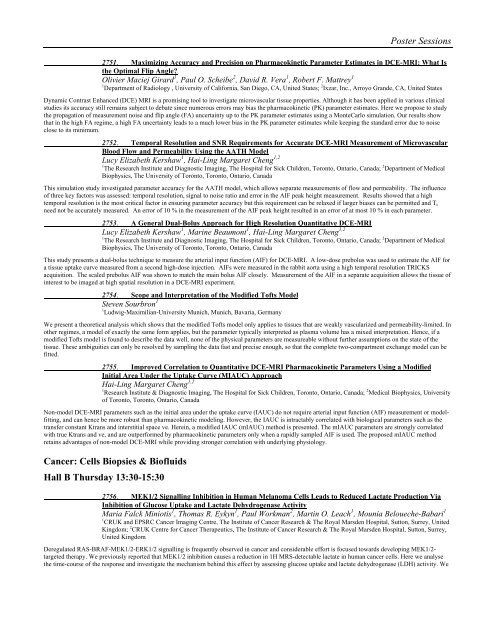TRADITIONAL POSTER - ismrm
TRADITIONAL POSTER - ismrm
TRADITIONAL POSTER - ismrm
Create successful ePaper yourself
Turn your PDF publications into a flip-book with our unique Google optimized e-Paper software.
Poster Sessions<br />
2751. Maximizing Accuracy and Precision on Pharmacokinetic Parameter Estimates in DCE-MRI: What Is<br />
the Optimal Flip Angle?<br />
Olivier Maciej Girard 1 , Paul O. Scheibe 2 , David R. Vera 1 , Robert F. Mattrey 1<br />
1 Department of Radiology , University of California, San Diego, CA, United States; 2 Ixzar, Inc., Arroyo Grande, CA, United States<br />
Dynamic Contrast Enhanced (DCE) MRI is a promising tool to investigate microvascular tissue properties. Although it has been applied in various clinical<br />
studies its accuracy still remains subject to debate since numerous errors may bias the pharmacokinetic (PK) parameter estimates. Here we propose to study<br />
the propagation of measurement noise and flip angle (FA) uncertainty up to the PK parameter estimates using a MonteCarlo simulation. Our results show<br />
that in the high FA regime, a high FA uncertainty leads to a much lower bias in the PK parameter estimates while keeping the standard error due to noise<br />
close to its minimum.<br />
2752. Temporal Resolution and SNR Requirements for Accurate DCE-MRI Measurement of Microvascular<br />
Blood Flow and Permeability Using the AATH Model<br />
Lucy Elizabeth Kershaw 1 , Hai-Ling Margaret Cheng 1,2<br />
1 The Research Institute and Diagnostic Imaging, The Hospital for Sick Children, Toronto, Ontario, Canada; 2 Department of Medical<br />
Biophysics, The University of Toronto, Toronto, Ontario, Canada<br />
This simulation study investigated parameter accuracy for the AATH model, which allows separate measurements of flow and permeability. The influence<br />
of three key factors was assessed: temporal resolution, signal to noise ratio and error in the AIF peak height measurement. Results showed that a high<br />
temporal resolution is the most critical factor in ensuring parameter accuracy but this requirement can be relaxed if larger biases can be permitted and T c<br />
need not be accurately measured. An error of 10 % in the measurement of the AIF peak height resulted in an error of at most 10 % in each parameter.<br />
2753. A General Dual-Bolus Approach for High Resolution Quantitative DCE-MRI<br />
Lucy Elizabeth Kershaw 1 , Marine Beaumont 1 , Hai-Ling Margaret Cheng 1,2<br />
1 The Research Institute and Diagnostic Imaging, The Hospital for Sick Children, Toronto, Ontario, Canada; 2 Department of Medical<br />
Biophysics, The University of Toronto, Toronto, Ontario, Canada<br />
This study presents a dual-bolus technique to measure the arterial input function (AIF) for DCE-MRI. A low-dose prebolus was used to estimate the AIF for<br />
a tissue uptake curve measured from a second high-dose injection. AIFs were measured in the rabbit aorta using a high temporal resolution TRICKS<br />
acquisition. The scaled prebolus AIF was shown to match the main bolus AIF closely. Measurement of the AIF in a separate acquisition allows the tissue of<br />
interest to be imaged at high spatial resolution in a DCE-MRI experiment.<br />
2754. Scope and Interpretation of the Modified Tofts Model<br />
Steven Sourbron 1<br />
1 Ludwig-Maximilian-University Munich, Munich, Bavaria, Germany<br />
We present a theoretical analysis which shows that the modified Tofts model only applies to tissues that are weakly vascularized and permeability-limited. In<br />
other regimes, a model of exactly the same form applies, but the parameter typically interpreted as plasma volume has a mixed interpretation. Hence, if a<br />
modified Tofts model is found to describe the data well, none of the physical parameters are measureable without further assumptions on the state of the<br />
tissue. These ambiguities can only be resolved by sampling the data fast and precise enough, so that the complete two-compartment exchange model can be<br />
fitted.<br />
2755. Improved Correlation to Quantitative DCE-MRI Pharmacokinetic Parameters Using a Modified<br />
Initial Area Under the Uptake Curve (MIAUC) Approach<br />
Hai-Ling Margaret Cheng 1,2<br />
1 Research Institute & Diagnostic Imaging, The Hospital for Sick Children, Toronto, Ontario, Canada; 2 Medical Biophysics, University<br />
of Toronto, Toronto, Ontario, Canada<br />
Non-model DCE-MRI parameters such as the initial area under the uptake curve (IAUC) do not require arterial input function (AIF) measurement or modelfitting,<br />
and can hence be more robust than pharmacokinetic modeling. However, the IAUC is intractably correlated with biological parameters such as the<br />
transfer constant Ktrans and interstitial space ve. Herein, a modified IAUC (mIAUC) method is presented. The mIAUC parameters are strongly correlated<br />
with true Ktrans and ve, and are outperformed by pharmacokinetic parameters only when a rapidly sampled AIF is used. The proposed mIAUC method<br />
retains advantages of non-model DCE-MRI while providing stronger correlation with underlying physiology.<br />
Cancer: Cells Biopsies & Biofluids<br />
Hall B Thursday 13:30-15:30<br />
2756. MEK1/2 Signalling Inhibition in Human Melanoma Cells Leads to Reduced Lactate Production Via<br />
Inhibition of Glucose Uptake and Lactate Dehydrogenase Activity<br />
Maria Falck Miniotis 1 , Thomas R. Eykyn 1 , Paul Workman 2 , Martin O. Leach 1 , Mounia Beloueche-Babari 1<br />
1 CRUK and EPSRC Cancer Imaging Centre, The Institute of Cancer Research & The Royal Marsden Hospital, Sutton, Surrey, United<br />
Kingdom; 2 CRUK Centre for Cancer Therapeutics, The Institute of Cancer Research & The Royal Marsden Hospital, Sutton, Surrey,<br />
United Kingdom<br />
Deregulated RAS-BRAF-MEK1/2-ERK1/2 signalling is frequently observed in cancer and considerable effort is focused towards developing MEK1/2-<br />
targeted therapy. We previously reported that MEK1/2 inhibition causes a reduction in 1H MRS-detectable lactate in human cancer cells. Here we analyse<br />
the time-course of the response and investigate the mechanism behind this effect by assessing glucose uptake and lactate dehydrogenase (LDH) activity. We















